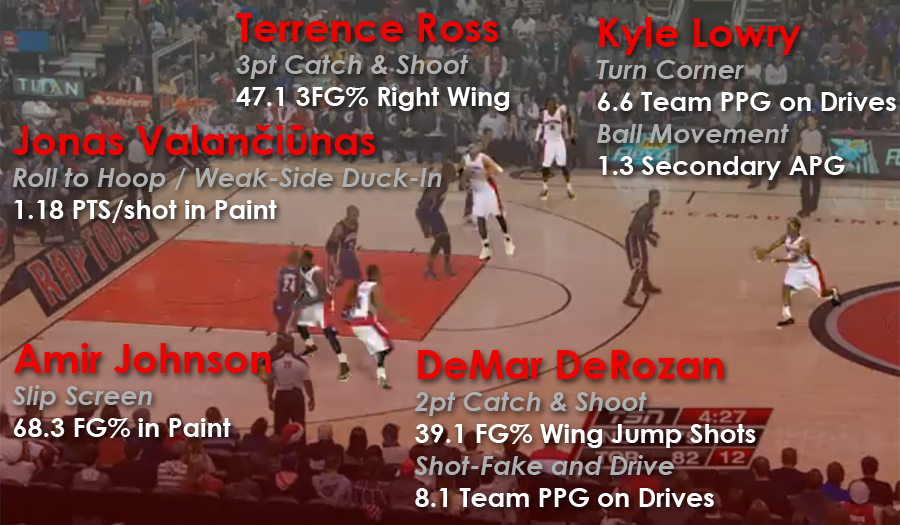The Play
Since the Rudy Gay trade, the Toronto Raptors have improved their offensive efficiency to 107 and – according to Zach Lowe – pass the ball thirty more times per game. In their most recent outing, a win versus the Indiana Pacers, Terrence Ross and DeMar DeRozan converted several quick hitters off BLOBs and pindown screens. There were several plays involving multiple ball reversals, secondary assists and more passes than dribbles. This High Ball Screen / Pin-down combination gashed the Pacers throughout the game.
The play offers a number of scoring options for Toronto that weren’t available when one player was stopping the ball and over-dribbling. In this case, all five players are moving (although the Raptors are still susceptible to standing still as one player dribbles). The play starts on the right hand side with an entry pass to Terrence Ross, who gives it back to Kyle Lowry. As Jonas Valančiūnas sets a high screen, Ross shorts the screen (cuts to an outside shot behind the ballhandler) and DeMar DeRozan uses a pin-down set by Amir Johnson.

The Skills Needed
For sets like this to work, players need to possess several key skills. As Dan Bylsma said about the recently named U.S. Olympic Men’s Hockey team, a team cannot have a team identity if players do not possess those characteristics. Coaches cannot run plays if players do not possess the skills needed for excellent execution.
Footwork: In the past thirty days, fifty three percent of DeRozan’s shots have been two point shots from outside the paint. It’s important that he take the shots quickly and in rhythm, instead of his past tendency to dribble and fade away. 2013 has been a poor shooting year for the guard but he does well when his footwork is sound. When DeRozan and Ross can step into their shots with a quick 1-2 step, they do not fade away and become more accurate. In order to shoot on both sides of the court, shooters must be able to pivot on either foot.
Screening and Rolling: DeRozan receives room from his defender Paul George, who is able to block his shot, if Johnson had not set a solid screen. When word gets out about Toronto’s wings catching and shooting, bigger defenders will have to hedge more, giving Johnson a chance to slip the screen and get a pass for a dunk.
Lowry does not drive as much as other guards because Valančiūnas often whiffs on his screens. Without separation from the defender, it is harder to turn the corner. The ball hasn’t penetrated into the paint at the time of Lowry’s pass to DeRozan so options are not as plentiful as they could be. A harder roll to the rim would make Valančiūnas available for a duck-in as DeRozan first catches the ball or if he chose to drive.
Cutting: Both DeRozan and Ross start their cuts at the baseline, which enables them to get the ball closer to the basket and in scoring position. When Ross first gets the ball, Johnson could have set a ball for him on the right side, although the Raptors do not utilize him in ball screens and isolations much. Had DeRozan received the ball first, Lowry could have cut through and Toronto could have run a number of sets from that position.
Unlike other sets the Raptors ran earlier in the year, the ball is reversed so it is necessary for everyone else to keep moving. DeRozan resets and is ready to use Johnson’s pin-down in order to get open as Lowry receives the ball. The shot goes up with eleven seconds remaining in the shot clock; this Toronto team only has an effective field goal percentage of 39.4 as the shot clock expires so it is imperative that they don’t sit around and wait.
Passing: Since the trade the Raptors assist on fifty-eight percent of their baskets (compared to forty-nine percent before). Lowry was particularly successful at driving into the key and moving the ball to teammates. The team, especially bench players, seems less selfish and accrued a number of “hockey assists” during the game. In order to do this, the players must be positioned in passing triangles that offer multiple passing lanes.
If Valančiūnas doesn’t set great screens, it is harder for the point guard to pass directly to the big, so other players must be ready to the post player when they receive the first pass. Toronto is a tough matchup because their 4s and 5s comprise a capable rotation. On the offensive end, they must remain well-spaced so that post-to-post passing is possible. If Valančiūnas were to get the ball in the high post, the timing would be perfect to make a high-low pass to Johnson after he set his screen.